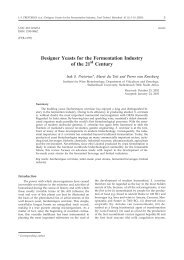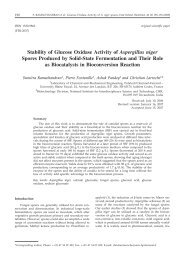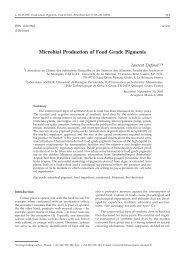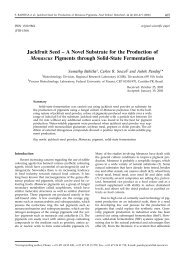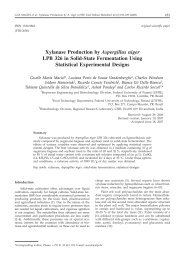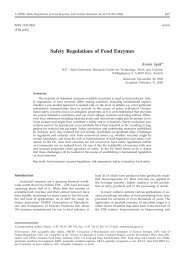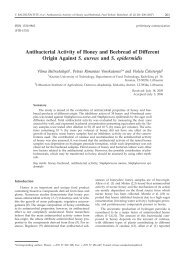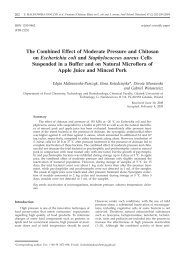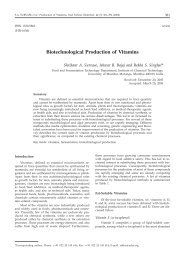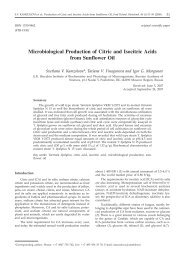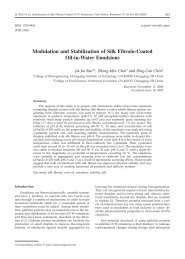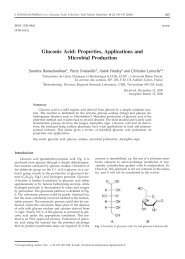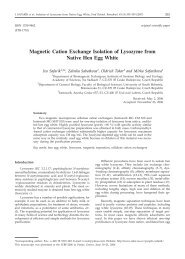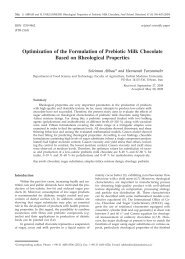Fungal Invertase Expression in Solid-State Fermentation - Food ...
Fungal Invertase Expression in Solid-State Fermentation - Food ...
Fungal Invertase Expression in Solid-State Fermentation - Food ...
Create successful ePaper yourself
Turn your PDF publications into a flip-book with our unique Google optimized e-Paper software.
C. ARANDA et al.: <strong>Fungal</strong> <strong>Invertase</strong> <strong>in</strong> SSF, <strong>Food</strong> Technol. Biotechnol. 44 (2) 229–233 (2006)<br />
229<br />
ISSN 1330-9862<br />
(FTB-1669)<br />
orig<strong>in</strong>al scientific paper<br />
<strong>Fungal</strong> <strong>Invertase</strong> <strong>Expression</strong> <strong>in</strong> <strong>Solid</strong>-<strong>State</strong> <strong>Fermentation</strong><br />
Cuitlahuac Aranda 1 , Armando Robledo 1 , Octavio Loera 2 ,<br />
Juan C. Contreras-Esquivel 1 , Raul Rodríguez 2 and Cristóbal Noé Aguilar 1 *<br />
1 <strong>Food</strong> Research Department, School of Chemistry, Universidad Autónoma de Coahuila, Blvd.<br />
Venustiano Carranza and Jose Cárdenas, Col. República, PO Box 252, 25000, Saltillo, Coahuila, Mexico<br />
2 Department of Biotechnology, Universidad Autónoma Metropolitana,<br />
Iztapalapa. Av. Michoacán y la Purisma, Col. Vicent<strong>in</strong>a, 09340, México, D.F. Mexico<br />
Received: October 30, 2005<br />
Accepted: February 11, 2006<br />
Summary<br />
In this study <strong>in</strong>vertase activity expression <strong>in</strong> Aspergillus niger Aa-20 was evaluated under<br />
different concentrations of two substrates us<strong>in</strong>g solid-state fermentation (SSF) on polyurethane<br />
foam. Glucose was used as repressor and sucrose was the <strong>in</strong>ducer. <strong>Invertase</strong> production<br />
<strong>in</strong>creased when glucose was present <strong>in</strong> the medium (up to 100 g/L); however,<br />
higher concentration than this reduced the enzyme production. Induction-repression ratio<br />
obta<strong>in</strong>ed us<strong>in</strong>g any glucose concentration was at least 2.5 times higher than that under<br />
basal conditions (without <strong>in</strong>ducer).<br />
Key words: <strong>in</strong>vertase, solid-state fermentation, expression k<strong>in</strong>etics<br />
Introduction<br />
<strong>Invertase</strong> (b-D-fructofuranoside-fructohydrolase, E.C.<br />
3.2.1.26) catalyzes the hydrolysis of sucrose to glucose<br />
and fructose. <strong>Invertase</strong> is one of the most widely used<br />
enzymes <strong>in</strong> food <strong>in</strong>dustry, especially <strong>in</strong> the preparation<br />
of jams and candies (1). The enzyme is a glycoprote<strong>in</strong>,<br />
with some residues of mannose be<strong>in</strong>g the major component<br />
of the carbohydrate moiety (2,3). <strong>Invertase</strong> is ma<strong>in</strong>ly<br />
used <strong>in</strong> the food <strong>in</strong>dustry, where fructose is preferred<br />
over sucrose because it is sweeter and does not crystallize<br />
easily. However, the use of <strong>in</strong>vertase is seriously limited<br />
because another enzyme, glucose isomerase, can<br />
be used to convert glucose to fructose at lower costs. A<br />
wide range of microorganisms produce <strong>in</strong>vertase and can,<br />
thus, utilize sucrose as the only carbon source and as <strong>in</strong>ducer<br />
of such enzyme. It has been extensively studied <strong>in</strong><br />
yeast and some fungi, ma<strong>in</strong>ly Neurospora sp. Commercially,<br />
<strong>in</strong>vertase is biosynthesized chiefly by yeast stra<strong>in</strong>s<br />
of Saccharomyces cerevisiae or S. carlsbergensis <strong>in</strong> submerged<br />
fermentation (SmF) (4). However, <strong>in</strong> SmF, it is<br />
well known that <strong>in</strong>vertase is strongly regulated by glucose<br />
repression or catabolic repression. This control system<br />
regulates expression of sucrose fermentation genes<br />
at the transcriptional level. Glucose addition to culture<br />
media with sucrose affects transport of sucrose <strong>in</strong>to the<br />
cell and thereby affects the function of regulatory mechanisms<br />
for <strong>in</strong>duction (5).<br />
Several studies have reported high enzymatic activity<br />
titers by solid-state fermentation (SSF) over SmF when<br />
high glucose concentrations were used. These observations<br />
have provoked a great controversy, because several<br />
authors considered that SSF was a process where<br />
the catabolic repression of <strong>in</strong>ducible enzymes did not take<br />
place or was m<strong>in</strong>imized (6–12). Several hypotheses have<br />
been proposed to expla<strong>in</strong> such differences <strong>in</strong> the enzyme<br />
activity titers, among which are the low water content,<br />
the nature of SSF, the diffusion of nutrients on solid matrix<br />
and the changes <strong>in</strong> the ratio between the substrate<br />
uptake rate and diffusivity substrate coefficient. Maldonado<br />
and Strasser de Saad (10) found differences <strong>in</strong> the<br />
fatty acid composition of cell membrane from Aspergillus<br />
niger grown <strong>in</strong> SmF and SSF for pect<strong>in</strong>ase production,<br />
conclud<strong>in</strong>g that those structural differences are directly<br />
*Correspond<strong>in</strong>g author; E-mail: cag13761@mail.uadec.mx
230 C. ARANDA et al.: <strong>Fungal</strong> <strong>Invertase</strong> <strong>in</strong> SSF, <strong>Food</strong> Technol. Biotechnol. 44 (2) 229–233 (2006)<br />
related to enzyme production <strong>in</strong> SSF. Recently Cerda-<br />
-Montalvo et al. (13) demonstrated experimentally the<br />
effect of substrate diffusion on enzyme expression. However,<br />
today it is still not clear why enzyme titers produced<br />
<strong>in</strong> SSF systems are significantly higher than <strong>in</strong> SmF<br />
systems (14); also the effect of addition of high amount<br />
of glucose on enzyme production <strong>in</strong> SSF is still not clear.<br />
Hence, the aim of this work was to study the effect of<br />
the addition of glucose on <strong>in</strong>vertase production <strong>in</strong> SSF<br />
us<strong>in</strong>g Aspergillus niger Aa-20 on polyurethane foam.<br />
Materials and Methods<br />
Microorganism and culture medium<br />
Spores of Aspergillus niger Aa-20 (UAMI-IRD Collection)<br />
used <strong>in</strong> this work were stored at –20 °C. Inoculum<br />
was prepared by transferr<strong>in</strong>g the spores to potato dextrose<br />
agar medium, <strong>in</strong>cubated at 30 °C for 5 days. Spores<br />
were scraped <strong>in</strong>to 0.01 % Tween 80 solution and counted<br />
<strong>in</strong> a Neubauer chamber. Composition of culture medium<br />
for <strong>in</strong>vertase production was (<strong>in</strong> g/L): KH 2 PO 4 4.38,<br />
(NH 4 ) 2 SO 4 8.76, MgSO 4·7H 2 O 0.88, CaCl 2·2H 2 O 0.088,<br />
MnCl 2·6H 2 O 0.018, Na 2 MoO 4·2H 2 O 0.0088, FeSO 4·2H 2 O<br />
0.012 and sucrose 25. Medium was supplemented with<br />
glucose at 6.25, 12.5, 25, 50, 100, 150 and 200 g/L. Basal<br />
<strong>in</strong>vertase activity was assayed from cultures with glucose<br />
(25 g/L) as the only carbon source.<br />
<strong>Solid</strong>-state fermentation (SSF)<br />
The SSF <strong>in</strong>volved the use of polyurethane foam (PUF)<br />
(Expomex, México) as a support to absorb the liquid medium.<br />
PUF was washed as reported by Zhu et al. (15)<br />
and then pulverised <strong>in</strong> a plastic mill. Column reactors<br />
(25 x 180 mm) were packed with 10 g of <strong>in</strong>oculated support<br />
(2·10 7 spores/g of dry <strong>in</strong>ert support). Culture conditionswere:30°C,aerationrateof20mLofairpergram<br />
of support per m<strong>in</strong>, <strong>in</strong>itial pH=5.5, <strong>in</strong>itial moisture content<br />
of 65 % and <strong>in</strong>cubation time of 32 h. For enzyme<br />
extraction, the content of each reactor was mixed with<br />
distilled water (1:10, mass per volume) and vortexed for<br />
1 m<strong>in</strong>. <strong>Solid</strong>s were filtered (Whatman 41) and the clear<br />
filtrate was assayed for extracellular <strong>in</strong>vertase activity.<br />
The rema<strong>in</strong><strong>in</strong>g solids were washed three times with 50<br />
mL of distilled water. Intracellular enzyme was recovered<br />
by freez<strong>in</strong>g the cells <strong>in</strong> liquid nitrogen and by macerat<strong>in</strong>g<br />
<strong>in</strong> a chilled mortar and mixed with acetate buffer<br />
(200 mM, pH=5.5). The fungal debris was removed by<br />
centrifugation and the result<strong>in</strong>g supernatant was assayed<br />
for <strong>in</strong>vertase activity. SSF system was conducted <strong>in</strong> three<br />
sets and the values were averaged.<br />
Analytical methods<br />
<strong>Fungal</strong> biomass production<br />
Consider<strong>in</strong>g that fungal biomass could not be measured<br />
accurately by gravimetry, it was determ<strong>in</strong>ed by<br />
measur<strong>in</strong>g the prote<strong>in</strong> concentration with a Bradford microassay<br />
(Bio-Rad ® ) accord<strong>in</strong>g to the technique reported<br />
by Córdova et al. (16), which evaluates the lag and exponential<br />
growth phases only.<br />
Enzyme assay<br />
<strong>Invertase</strong> activity was assayed by the d<strong>in</strong>itrosalicylic<br />
acid technique (17) to estimate the release of reduc<strong>in</strong>g<br />
sugars us<strong>in</strong>g the follow<strong>in</strong>g reaction mixture: 1.9 mL of<br />
substrate (100 mM sucrose <strong>in</strong> 100 mM acetate buffer,<br />
pH=5.0) and 0.1 mL of enzyme extract <strong>in</strong>cubated for 30<br />
m<strong>in</strong> at 30 °C. One <strong>in</strong>ternational unit (IU) of enzyme was<br />
def<strong>in</strong>ed as the amount of catalyst able to release 1 mmol<br />
of reduc<strong>in</strong>g sugar per m<strong>in</strong>ute per millilitre. All data<br />
po<strong>in</strong>ts correspond to triplicates of <strong>in</strong>dependent experiments.<br />
Sugar determ<strong>in</strong>ations<br />
Total sugar quantification was carried out us<strong>in</strong>g the<br />
phenol-sulphuric acid method (18). Sucrose, glucose and<br />
fructose concentrations were evaluated by HPLC chromatography<br />
us<strong>in</strong>g a Shodex SC-LG column.<br />
Presence of other metabolites<br />
Production of other metabolites (trehalose, citric acid<br />
and polyols) was evaluated by HPLC chromatography<br />
us<strong>in</strong>g a C-18 column.<br />
Calculation of metabolic parameters<br />
The major metabolic parameters <strong>in</strong>clud<strong>in</strong>g specific<br />
growth rate (m), biomass yield (Y X/S ), enzyme yield (Y P ),<br />
specific sugar uptake rate (q s ) and <strong>in</strong>duction-repression<br />
ratio (R I/R ) were calculated. Specific growth rate, m, was<br />
obta<strong>in</strong>ed from growth curves fitted by a Marquardt computer<br />
program (Solver-Excel, Microsoft) us<strong>in</strong>g the logistic<br />
equation as follows:<br />
dX<br />
dt<br />
⎛ X<br />
= m ⎜1−<br />
⎝ X<br />
max<br />
⎞<br />
⎟X<br />
⎠<br />
/1/<br />
where m (1/h) was the maximal growth rate and X and<br />
X max were the biomass concentrations at times t and<br />
t→∞, respectively. The algorithm m<strong>in</strong>imized the sum of<br />
the least square errors, compar<strong>in</strong>g experimental data with<br />
the theoretical values given by the next equation:<br />
Xt ()<br />
Xmax<br />
=<br />
Xmax<br />
− X0<br />
1+<br />
e<br />
X<br />
0<br />
− mt<br />
/2/<br />
X 0 be<strong>in</strong>g the biomass concentration at time t=0.<br />
The overall biomass yield, Y X/S , def<strong>in</strong>ed as the<br />
amount of biomass produced per gram of sugar utilised,<br />
was approximated from:<br />
∆X Xmax − X0<br />
YX/S = =<br />
/3/<br />
∆S<br />
S − S<br />
where S and S 0 are substrate concentrations <strong>in</strong> the fermentor<br />
at times t=0 and t→∞, respectively.<br />
Enzyme yield, Y P , the <strong>in</strong>vertase activity produced per<br />
gram of biomass of fungal cells was approximated from:<br />
∆E Emax −E0<br />
YP = =<br />
/4/<br />
∆X<br />
X − X<br />
where E max and E 0 are the <strong>in</strong>ternational units of <strong>in</strong>vertase<br />
activity <strong>in</strong> the extract at times t=0 and t→∞, respectively.<br />
0<br />
0
C. ARANDA et al.: <strong>Fungal</strong> <strong>Invertase</strong> <strong>in</strong> SSF, <strong>Food</strong> Technol. Biotechnol. 44 (2) 229–233 (2006)<br />
231<br />
The specific sugar uptake rate, q S , def<strong>in</strong>ed as the<br />
amount of sugar consumed per gram of biomass per<br />
hour, was calculated from:<br />
q<br />
S<br />
= m /5/<br />
Y<br />
Induction-repression ratio, R I/R , def<strong>in</strong>ed as <strong>in</strong>vertase<br />
activity <strong>in</strong>duced <strong>in</strong> a medium with glucose and sucrose<br />
per basal <strong>in</strong>vertase activity <strong>in</strong> a medium without sucrose,<br />
was calculated from:<br />
IAI<br />
R I/R = /6/<br />
BIA<br />
where IAI is the <strong>in</strong>vertase activity produced <strong>in</strong> a medium<br />
with <strong>in</strong>ducer (sucrose) and repressor (glucose), and<br />
BIA is the basal <strong>in</strong>vertase activity produced <strong>in</strong> a medium<br />
without <strong>in</strong>ducer.<br />
Statistical analysis<br />
All results were evaluated us<strong>in</strong>g the analysis of variance<br />
and Tukey's test for comparison of means <strong>in</strong> the<br />
statistical program InStat for Mac<strong>in</strong>tosh.<br />
Results and Discussion<br />
In this study the stra<strong>in</strong> A. niger Aa-20 was adapted on<br />
media with sucrose, or mixtures of glucose-sucrose, although<br />
it has generally been characterized as producer of<br />
tannase (19). Fig. 1 shows the values of maximum biomass<br />
production (X max ) and the specific growth rate values (m).<br />
Evidently, under conditions used, the X max was not significantly<br />
affected by the addition of glucose <strong>in</strong> a range from<br />
6.25 to 150 g/L, and <strong>in</strong>creased to 200 g/L. The mould cultured<br />
<strong>in</strong> SSF grew faster (0.2 to 0.53 h –1 ) when <strong>in</strong>itial glucose<br />
concentration was <strong>in</strong>creased from zero to 25 g/L.<br />
m/h<br />
0.6<br />
0.5<br />
0.4<br />
0.3<br />
0.2<br />
0.1<br />
0.0<br />
Maximal <strong>in</strong>vertase production values are shown <strong>in</strong><br />
Fig. 2a. BIA (or constitutive level of <strong>in</strong>vertase activity)<br />
produced by A. niger Aa-20 <strong>in</strong> SSF with glucose as the<br />
only carbon source was always lower than <strong>in</strong> any other<br />
experiment, which was due to the presence of sucrose <strong>in</strong><br />
the medium. Intracellular <strong>in</strong>vertase activity was seriously<br />
affected by the addition of glucose, but extracellular<br />
<strong>in</strong>vertase activity was not affected. Fig. 2b shows<br />
X/S<br />
BIA 0 6 12 25 50 100 150 200<br />
Concentration/(g/L)<br />
Fig 1. Effect of glucose concentration on biomass production<br />
and specific growth rate of Aspergillus niger Aa-20. Bars represent<br />
the X max values and l<strong>in</strong>e is m.<br />
12<br />
10<br />
8<br />
6<br />
4<br />
2<br />
0<br />
Biomass/(g/L)<br />
<strong>Invertase</strong> activity/(IU/L)<br />
<strong>Invertase</strong> activity/(IU/L)<br />
250<br />
200<br />
150<br />
100<br />
50<br />
0<br />
350<br />
300<br />
250<br />
200<br />
150<br />
100<br />
50<br />
0<br />
a<br />
Intracellular<br />
Extracellular<br />
BIA 0 6 12 25 50 100 150 200<br />
Concentration/(g/L)<br />
Extra/<strong>in</strong>tracellular ratio<br />
b<br />
Total <strong>in</strong>vertase activity<br />
BIA 0 6 12 25 50 100 150 200<br />
Concentration/(g/L)<br />
Fig 2. Effect of glucose concentration on (a) <strong>in</strong>tracellular and<br />
extracellular <strong>in</strong>vertase production, and (b) <strong>in</strong>tra/extracellular<br />
ratio and total <strong>in</strong>vertase activity<br />
that the extra/<strong>in</strong>tracellular ratio was decreased by glucose<br />
addition <strong>in</strong> a range of 0 to 50 g/L, but it <strong>in</strong>creased<br />
with higher <strong>in</strong>itial glucose concentration. Glucose addition<br />
<strong>in</strong> a range of 6.25 up to 100 g/L <strong>in</strong>creased the total<br />
<strong>in</strong>vertase activity, but it decreased 32 and 41 % when<br />
glucose concentrations of 150 and 200 g/L were used,<br />
respectively. However, total <strong>in</strong>vertase activity obta<strong>in</strong>ed<br />
for 200 g/L (187 IU/L) was higher than BIA. This result<br />
appeared important, as it demonstrated that at high glucose<br />
concentration the phenomenon of catabolic repression<br />
was not present <strong>in</strong> SSF process under the conditions<br />
used. Fig. 3 showed that R I/R value <strong>in</strong>creased when<br />
the <strong>in</strong>itial glucose concentration was <strong>in</strong> a range from 0<br />
RI/R<br />
5<br />
4<br />
3<br />
2<br />
1<br />
0<br />
0 50 100 150 200<br />
Concentration/(g/L)<br />
Fig 3. Effect of glucose concentration on <strong>in</strong>duction-repression<br />
ratio, R I/R<br />
5<br />
4<br />
3<br />
2<br />
1<br />
0<br />
Extra/Intracellular ratio
232 C. ARANDA et al.: <strong>Fungal</strong> <strong>Invertase</strong> <strong>in</strong> SSF, <strong>Food</strong> Technol. Biotechnol. 44 (2) 229–233 (2006)<br />
Table 1. K<strong>in</strong>etic parameters of <strong>in</strong>vertase production by Aspergillus niger Aa-20<strong>in</strong>SSF<br />
g(glucose) g(sucrose) Y x/s Y p q s q p IE<br />
g/L g/L g/g IU/g g/(g·h) IU/(g·h) IU/g<br />
25 0 0.781 6.729 0.521 2.739 –0.192<br />
0 25 0.233 33.091 0.858 6.618 0.222<br />
6.25 25 0.107 60.909 3.584 23.389 0.165<br />
12.5 25 0.111 64.872 4.747 34.317 0.235<br />
25 25 0.103 62.927 5.151 33.477 0.443<br />
50 25 0.075 70.732 6.081 32.183 0.530<br />
100 25 0.064 71.591 6.721 30.999 0.775<br />
150 25 0.042 49.767 10.536 21.997 0.312<br />
200 25 0.070 19.278 6.471 8.733 0.094<br />
to 100 g/L, but it decreased at higher concentrations. It<br />
is important to note that R I/R value obta<strong>in</strong>ed <strong>in</strong> the presence<br />
of any glucose concentration was at least 2.5 times<br />
higher than the value obta<strong>in</strong>ed for BIA.<br />
Table 1 shows data obta<strong>in</strong>ed for k<strong>in</strong>etic parameters<br />
dur<strong>in</strong>g the evaluation of <strong>in</strong>vertase production on solid-<br />
-state culture at different substrate conditions. A. niger<br />
Aa-20 presented the highest value of Y X/S us<strong>in</strong>g glucose<br />
as the sole carbon source, however, when the <strong>in</strong>itial glucose<br />
concentration was <strong>in</strong>cremented <strong>in</strong> the presence of<br />
sucrose, a dramatic reduction of its value was observed.<br />
In contrast, <strong>in</strong>crements <strong>in</strong> Y P , q S and q P values were registered.<br />
Under solid-state fermentation of the culture at<br />
32 h, the <strong>in</strong>crement <strong>in</strong> the <strong>in</strong>itial glucose concentration<br />
favoured the <strong>in</strong>vertase production and seriously affected<br />
the biomass formation. <strong>Invertase</strong> expression (IE), def<strong>in</strong>ed<br />
as the enzyme produced per gram of biomass generated,<br />
demonstrated that it was maximum when 100 g/L<br />
of glucose and 25 g/L of sucrose were used, and when<br />
substrate concentration was <strong>in</strong>creased, a serious reduction<br />
of its value, ma<strong>in</strong>ly due to strong effect of <strong>in</strong>hibition<br />
of substrate on fungal growth, was observed.<br />
The production of <strong>in</strong>vertase from Penicillium sp. and<br />
Aspergillus sp. has been reported (20–24). Production of<br />
<strong>in</strong>vertase by SSF has potential advantages over the SmF<br />
with respect to simplicity <strong>in</strong> operation, high productivity<br />
fermentation, it is less favourable for growth of contam<strong>in</strong>ants<br />
and concentrated product formation. The k<strong>in</strong>etics<br />
of <strong>in</strong>vertase production by filamentous fungi <strong>in</strong><br />
SmF has been studied extensively (25–27). However,<br />
there is not enough <strong>in</strong>formation about the comparison of<br />
the <strong>in</strong>vertase expressed by SSF and SmF conditions. Generally<br />
the fermentation media and their components<br />
and stra<strong>in</strong>s that are used <strong>in</strong> SmF have been used <strong>in</strong> SSF<br />
too (28). However, certa<strong>in</strong> <strong>in</strong>vestigations clearly <strong>in</strong>dicated<br />
that the stra<strong>in</strong>s used <strong>in</strong> SmF are less efficient <strong>in</strong><br />
SSF. Ashokkumar et al. (28) described the comparison of<br />
<strong>in</strong>vertase production by A. niger under two different fermentation<br />
conditions and optimization of media us<strong>in</strong>g a<br />
fractional factorial design, to improve the <strong>in</strong>vertase production<br />
under SmF and SSF conditions.<br />
Romero-Gómez et al. (23) published data show<strong>in</strong>g<br />
that three stra<strong>in</strong>s of A. niger produced higher titers of<br />
<strong>in</strong>vertase and had higher observed productivity when<br />
cultured by SSF as compared to SmF. The trend for SmF<br />
and SSF systems was followed up by the Monod equation<br />
with substrate <strong>in</strong>hibition. Nevertheless, it was worth<br />
notic<strong>in</strong>g that <strong>in</strong>hibition constant value for SSF was significantly<br />
higher than for SmF. Altogether, results showed<br />
that A. niger grew more efficiently <strong>in</strong> SSF than <strong>in</strong> SmF<br />
when the <strong>in</strong>itial level of sucrose was high. They <strong>in</strong>dicated<br />
that excess sucrose helped to prevent the breakdown<br />
of <strong>in</strong>vertase <strong>in</strong> SSF system (12). It was <strong>in</strong>terest<strong>in</strong>g<br />
to note that there was a consistent behaviour <strong>in</strong> the enzyme<br />
<strong>in</strong>duction patterns and the results <strong>in</strong> this study<br />
were well correlated with those obta<strong>in</strong>ed for tannase<br />
production reported previously (11).<br />
Conclusions<br />
These results seemed important as they demonstrated<br />
that a high glucose concentration, the phenomenon<br />
of catabolic repression, was not present <strong>in</strong> SSF process<br />
under conditions used for <strong>in</strong>vertase production.<br />
Acknowledgements<br />
This work was f<strong>in</strong>anced by CONACYT-SEP 42244<br />
and FOMIX COAHUILA-CONACYT COAH-2002–4652.<br />
References<br />
1. R.D. Kle<strong>in</strong>, M.R. Deibel Jr., J.L. Sarcich, H.A. Zurcher-Neely,<br />
I.M. Reardon, R.L. He<strong>in</strong>rikson, Purification and characterization<br />
of <strong>in</strong>vertase from a novel <strong>in</strong>dustrial yeast, Schwanniomyces<br />
occidentalis, Prep. Biochem. 19 (1989) 293–319.<br />
2. S. Gascón, N.P. Neumann, J.O. Lampen, Comparative study<br />
of the properties of the purified <strong>in</strong>ternal and external<br />
<strong>in</strong>vertases from yeast, J. Biol. Chem. 243 (1968) 1573–1577.<br />
3. J.S. Chen, J. Saxton, F.W. Hemm<strong>in</strong>g, J.F. Peberdy, Purification<br />
and partial characterization of the high and low molecular<br />
weight form (S- and F-form) of <strong>in</strong>vertase secreted<br />
by Aspergillus nidulans, Biochim. Biophys. Acta, 1296 (1996)<br />
207–218.<br />
4. J. Wang, Y. Liu, B. Yao, Y. Wang, A study on screen<strong>in</strong>g<br />
and high density cell cultivation of a yeast stra<strong>in</strong> Kluyveromyces<br />
with high <strong>in</strong>ul<strong>in</strong>ase yield<strong>in</strong>g and its enzymology<br />
properties, Sheng Wu Gong Cheng Xue Bao, 16 (2000) 60–64.<br />
5. L. Neigeborn, M. Carlson, Mutations caus<strong>in</strong>g constitutive<br />
<strong>in</strong>vertase synthesis <strong>in</strong> yeast: Genetic <strong>in</strong>teractions with snf<br />
mutations, Genetics, 115 (1987) 247–253.<br />
6. M.V. Ramesh, B.K. Lonsane, Ability of a solid state fermentation<br />
technique to significantly m<strong>in</strong>imize catabolic repression<br />
of a-amylase production by Bacillus licheniformis<br />
M27, Appl. Microbiol. Biotechnol. 35 (1991) 591–593.
C. ARANDA et al.: <strong>Fungal</strong> <strong>Invertase</strong> <strong>in</strong> SSF, <strong>Food</strong> Technol. Biotechnol. 44 (2) 229–233 (2006)<br />
233<br />
7. S. Solís-Pereyra, E. Favela-Torres, G. V<strong>in</strong>iegra-González, M.<br />
Gutiérrez-Rojas, Effect of different carbon sources on the<br />
synthesis of pect<strong>in</strong>ases by Aspergillus niger <strong>in</strong> submerged<br />
and solid state fermentations, Appl. Microbiol. Biotechnol. 39<br />
(1993) 36–41.<br />
8. M. Acuñá-Argüelles, M. Gutiérrez-Rojas, G. V<strong>in</strong>iegra-González,<br />
E. Favela-Torres, Production and properties of three<br />
pect<strong>in</strong>olytic activities produced by Aspergillus niger by submerged<br />
and solid state fermentation, Appl. Microbiol. Biotechnol.<br />
43 (1995) 808–814.<br />
9. P.K. Lekha, B.K. Lonsane, Production and application of<br />
tann<strong>in</strong> acyl hidrolase: <strong>State</strong> of the art, Adv. Appl. Microbiol.<br />
44 (1997) 215–260.<br />
10. M.C. Maldonado, M.A. Strasser de Saad, Production of pect<strong>in</strong>esterase<br />
and polygalacturonase by Aspergillus niger <strong>in</strong><br />
submerged and solid state systems, J. Ind. Microbiol. Biotechnol.<br />
20 (1998) 34–38.<br />
11. C.N. Aguilar, C. Augur, E. Favela-Torres, G. V<strong>in</strong>iegra-González,<br />
Induction and repression patterns of fungal tannase<br />
<strong>in</strong> solid state and submerged cultures, Process Biochem. 36<br />
(2001) 571–578.<br />
12. G. V<strong>in</strong>iegra-González, E. Favela-Torres, C.N. Aguilar, S.J.<br />
Romero-Gómez, G. Diaz-God<strong>in</strong>ez, C. Augur, Advantages<br />
of fungal enzyme production <strong>in</strong> solid state over liquid fermentation<br />
systems, Biochem. Eng. J. 13 (2003) 157–167.<br />
13. M.L. Cerda-Montalvo, J.C. Contreras-Esquivel, R. Rodriguez-<br />
-Herrera, C.N. Aguilar, Glucose diffusion on support for<br />
solid-state fermentation and its <strong>in</strong>fluence on tannase production<br />
profiles, Inter. J. Chem. Reactor Eng. 3 (2005) 1–10.<br />
14. A. Pandey, P. Selvakumar, C.R. Soccol, P. Nigam, <strong>Solid</strong>-<br />
-state fermentation for the production of <strong>in</strong>dustrial enzymes,<br />
Curr. Sci. 77 (1999) 149–162.<br />
15. Y. Zhu, J. Smith, W. Knol, J. Bol, A novel solid state fermentation<br />
system us<strong>in</strong>g polyurethane foam as <strong>in</strong>ert carrier,<br />
Biotechnol. Lett. 16 (1994) 643–648.<br />
16. J. Córdova, M. Gutiérrez-Rojas, S. Huerta, G. Saucedo-Castañeda,<br />
E. Favela-Torres, Biomass estimation of Aspergillus<br />
niger grow<strong>in</strong>g on real and model supports <strong>in</strong> solid state<br />
fermentation, Biotechnol. Tech. 10 (1996) 1–6.<br />
17. G.L. Miller, Use of d<strong>in</strong>itrosalicylic acid reagent for determ<strong>in</strong>ation<br />
of reduc<strong>in</strong>g sugar, Anal. Chem. 31 (1959) 426–428.<br />
18. M. Dubois, K.A. Gilles, J. Hamilton, P.A. Rebers, F. Smith,<br />
Colorimetric method for determ<strong>in</strong>ation of sugar relates substances.<br />
Anal. Chem. 28 (1956) 350–356.<br />
19. A. Ramirez-Coronel, A. Darvill, G. V<strong>in</strong>iegra-González, C.<br />
Augur, Characterization of a bifunctional tannase from Aspergillus<br />
niger, Microbiology, 149 (2003) 2941–2946.<br />
20. S. Sirisansaneeyakul, S. Jitbanjongkit, N. Prasomsart, P. Luangpituksa,<br />
Production of b-fructofuranosidase from Aspergillus<br />
niger ATCC 20611, Kasetsart J. (Nat. Sci.), 34 (2000)<br />
378–386.<br />
21. M. Hirayama, N. Sumi, H. Hidaka, Purification and properties<br />
of a fructooligosaccharide-produc<strong>in</strong>g b-fructofuranosidase<br />
from Aspergillus niger ATCC 20611, Agr. Biol. Chem.<br />
53 (1989) 668–674.<br />
22. S. Hayashi, β-fructofuranosidase production by 2-deoxyglucose<br />
resistant mutants of Aspergillus niger <strong>in</strong> submerged and<br />
solid-state fermentation, Indian J. Exp. Biol. 40 (2002) 1032–<br />
1037.<br />
23. S. Romero-Gómez, C. Augur, G. V<strong>in</strong>iegra-González, <strong>Invertase</strong><br />
production by Aspergillus niger <strong>in</strong> submerged and solid-state<br />
fermentation, Biotechnol. Lett. 22 (2000) 1255–1258.<br />
24. A.M. Montiel-González, F.J. Fernandez, G. V<strong>in</strong>iegra-González,<br />
O. Loera, <strong>Invertase</strong> production on solid-state fermentation<br />
by Aspergillus niger stra<strong>in</strong>s improved by parasexual<br />
recomb<strong>in</strong>ation, Appl. Biochem. Biotechnol. 102 (2002) 63–70.<br />
25. P. Layman, Promis<strong>in</strong>g new markets emerg<strong>in</strong>g for commercial<br />
enzymes, Chem. Eng. News, 68 (1990) 17–18.<br />
26. L.M. Harvey, B. McNeil: Liquid <strong>Fermentation</strong> Systems and<br />
Product Recovery of Aspergillus. In: Biotechnology Handbooks,<br />
Vol. 7, J.E. Smith (Ed.), Plenum Press, New York,<br />
USA (1993).<br />
27. K.H. Kroner, H. Hustedt, M.R. Kula, Extractive enzyme recovery:<br />
Economic considerations, Process Biochem. 19 (1984)<br />
170–179.<br />
28. B. Ashokkumar, N. Kayalvizhi, P. Gunasekaran, Optimization<br />
of media for b-fructofuranosidase production by Aspergillus<br />
niger <strong>in</strong> submerged and solid state fermentation,<br />
Process Biochem. 37 (2001) 331–338.
FTB 44 (2) 229-233.<br />
Ekspresija <strong>in</strong>vertaze iz plijesni tijekom uzgoja na čvrstoj podlozi<br />
Sažetak<br />
U ovom je istraživanju ocijenjena ekspresija aktivnosti <strong>in</strong>vertaze u soju plijesni<br />
Aspergillus niger Aa-20 pri različitim koncentracijama dvaju supstrata tijekom rasta na<br />
čvrstoj podlozi od poliuretanske pjene. Kao represor upotrijebljena je glukoza, a kao <strong>in</strong>duktor<br />
saharoza. Proizvodnja <strong>in</strong>vertaze povećala se dodatkom do 100 g glukoze na litru podloge, a<br />
pri većim koncentracijama se smanjila. Omjer <strong>in</strong>dukcije i represije pri svim koncentracijama<br />
glukoze bio je 2,5 puta veći od onog pri osnovnim uvjetima (bez <strong>in</strong>duktora).



